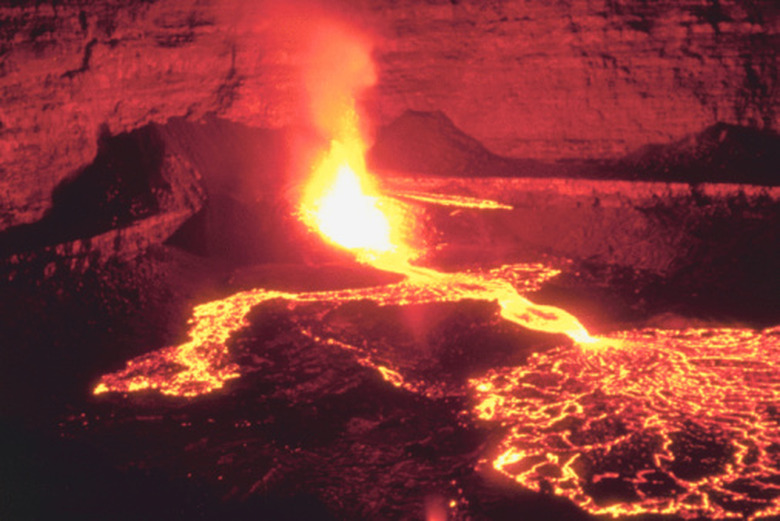A List Of Extrusive Igneous Rocks
Rocks formed from magma are called igneous rocks. Intrusive igneous rocks form when magma cools inside the Earth. Rocks that form from magma erupting onto the Earth's surface are called extrusive igneous rocks. Extrusive igneous rocks have little to no time to crystallize and, as a result, the crystals are very small or microscopic.
TL;DR (Too Long; Didn't Read)
Examples of extrusive igneous rocks are basalt, andesite, rhyolite, dacite, obsidian, pumice and scoria. Komatiite, a rare extrusive igneous rock, required much hotter melting temperatures to form than occur now.
Types of Igneous Rocks
Types of Igneous Rocks
All igneous rocks form from magma, or molten rock. Magma forms within the Earth's crust and mantle when heat and pressure cause rocks to melt. The lower density of the molten material causes the magma to rise toward the surface. When the magma cools within the Earth's crust or mantle, the insulation of the Earth's crust slows the cooling process. The slower the cooling process, the larger crystals within the magma can grow. Igneous rocks that cool beneath the Earth's surface are called intrusive igneous rocks.
Extrusive igneous rocks form when magma erupts onto the Earth's surface. Magma that flows onto the surface is called lava. When exposed to air and water, the molten rock or lava cools very quickly. The rapid cooling prevents the molecules in the lava from forming large crystals. The faster the lava cools, the smaller the crystals. In some cases, no crystals form at all, resulting in volcanic glass. An extrusive igneous rocks definition from the US Geological Survey states that "Extrusive, or volcanic, igneous rock is produced when magma exits and cools above (or very near) the Earth's surface."
Examples of Extrusive Igneous Rocks
Examples of Extrusive Igneous Rocks
Chemical composition differentiates types of igneous rocks. Color, density and eruptive environment help field identification. The following igneous rock names list identifies important examples of extrusive igneous rocks.
Basalt
Basalt is an iron-rich, very dark colored extrusive igneous rock. Basalt is very abundant beneath the ocean floor and is the most common volcanic rock in the Earth's crust. Basalt forms when the upper mantle melts. The low viscosity magma rises mostly along spreading centers to form new ocean crust. Hot spots around the world also erupt basalt to form island chains like the Galápagos and Hawaiian Islands, which are shield volcanoes tall enough to stand above the ocean's surface.
Obsidian
Obsidian, also known as volcanic glass, forms when silica-rich magma cools almost instantly, often due to contact with water. Obsidian ranges in color from black to deep greens and purples. Obsidian's glass-like structure forms very sharp edges, making obsidian useful for arrowheads, spear points and scalpels.
Andesite
Andesite is named for the Andes mountains and forms at continental margins along subduction zones of the ocean's tectonic plates. Andesite is composed of plagioclase, pyroxene, magnetite, quartz and sphene. Andesite may be white, gray or shades of white or gray.
Dacite
Dacite is a silica-rich extrusive igneous rock first discovered in Dacia, which was a providence of the Roman Empire. Dacite is light colored, usually pale or bluish gray.
Rhyolite
Rhyolite is a silica-rich rock, usually occurring in white to gray to pale pink shades. The chemical composition is like granite, although rhyolite is an extrusive igneous rock while granite is an intrusive igneous rock. Rhyolite's crystals are very small, making them hard if not impossible to see. Rhyolite may be used in decorations and jewelry due to the interesting banding colors. Because of its high viscosity (thickness), rhyolitic lavas cause explosive eruptions.
Pumice
Pumice is light to dark gray and forms from rapidly cooled lava that is full of gases and air. When lava forms a frothy texture, pumice is created. Pumice is so light and airy that many samples float on water. Pumice's rough texture makes it ideal in the beauty industry to scrub away dead and dry skin.
Scoria
Scoria is dark red to black in color. It is less viscous than pumice, but forms from lava that is rich in gases. Scoria therefore contains many holes from gas bubbles caught as the lava cools. Scoria is heavier than pumice and does not float on water. Scoria is the primary rock for cinder cone volcanoes. The name derives from a similar term that means "waste."
Komatiite
Komatiite is a very rare extrusive igneous rock only formed from incredibly hot magnesium-rich magma. The lava is so hot that it flows like water. The Earth does not have conditions suitable to form komatiite and has not been in the state to form komatiite for over 2 billion years, making any komatiite formations a minimum of 2 billion years old. Komatiite appears in various shades of gray.
References
- Science Views: Igneous Rocks
- Galleries.com: Igneous Rocks
- US Geological Survey: What are Igneous Rocks?
- Georgia Southwestern State University: Igneous Rocks-Volcanic (Extrusive) Rocks
- University of Comenius, Bratislava: Atlas of Magmatic Rocks-Komatiite
- University of Maryland: The Formation and Geological Setting of the Galápagos Islands
Cite This Article
MLA
Rumble, Amanda. "A List Of Extrusive Igneous Rocks" sciencing.com, https://www.sciencing.com/list-extrusive-igneous-rocks-8534625/. 12 October 2018.
APA
Rumble, Amanda. (2018, October 12). A List Of Extrusive Igneous Rocks. sciencing.com. Retrieved from https://www.sciencing.com/list-extrusive-igneous-rocks-8534625/
Chicago
Rumble, Amanda. A List Of Extrusive Igneous Rocks last modified March 24, 2022. https://www.sciencing.com/list-extrusive-igneous-rocks-8534625/
